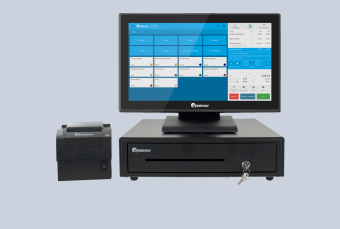Point of Purchase Displays: Create a Memorable Shopping Experience
In traditional marketing, marketers set out to do one of three things: to inform the customer of a product or service, to evaluate its usefulness, or persuade the customer to purchase it. Different marketing techniques do this in different ways, but the desired outcome is always the same.
Point of purchase displays use a slightly different approach. With point of purchase (POP) displays, retailers can interrupt the customer journey and influence their purchasing decisions at the last possible moment.
When used correctly, point of purchase displays can have a very positive effect on your sales. In this blog, we'll be exploring point of purchase displays in detail. We'll cover what a POP display is, compare point of purchase vs point of sale, and how you can incorporate POP displays into your business to improve your retail performance.
What is a POP display?
In simple terms, a point of purchase display describes a display showing retail marketing material for a particular product. These POP displays are generally physical, freestanding displays, although digital POP displays have become increasingly popular as technology has improved. Point of purchase displays are set up at strategic locations around the store and are most often found near or next to the checkout counter.
Point of purchase displays are common players in retail strategy. Retailers that are targeting impulse buyers use point of purchase displays to get consumers to add a particular product or service to their basket just before their final transaction. To reach these impulsive consumers, a retailer will place a POP display as an endcap display (at the end of the aisles) or in areas where the customer walks by.
Many types of retail stores incorporate point of purchase displays into their marketing strategy to help drive sales. Point of purchase displays are not intended to improve footfall as the customer needs to already be in the store to see the display. Instead, point of purchase displays are intended to capture a customer's attention and emphasize a chosen product or service.
Point of sale
A point of sale system refers to a machine that processes transactions and helps staff to manage a business. Point of sale systems were originally mechanical cash registers that would sit on the counter of a retail store. Since those early days, the simple cash register has evolved to incorporate new technology and digital systems.
Digital point of sale systems are complicated pieces of technology that can completely revolutionize the way a business operates. For instance, the Epos Now Complete Solution has several useful features including payment processing services, retail operations management tools, and a suite of leading integrations.
Now we’ve explained them both, we can see the fundamental difference between POP and POS:
- POP displays are pure marketing tools used to influence consumer buying behavior.
- POS systems are tools that businesses use to process their transactions and streamline their processes.
That isn't to say that point of sale systems can't be used to support your POP display strategy though! In retail settings like department stores, point of sale systems are almost always busy with customer traffic. A savvy move would be to put smaller POP displays next-to your POS terminal. This allows you to implement point of purchase marketing right up until the final moment of the transaction.
Gain all the advantages of a POS system with detailed, flexible, downloadable reports, and so much more.

Types of POP displays
In POP display marketing, there are several different types of displays that you can use. While retail displays can be found in almost every store, different types of displays will work better in certain situations and locations. To help you understand what displays will work best in your store, we've compiled a list of the different types of point of purchase displays that are currently available.
Temporary displays
Customers interact with temporary displays every day. Temporary POP displays are used in almost every shop and can be found in a wide variety of shapes and sizes. These displays are usually made out of a cheap material such as corrugated cardboard. They are most often in the form of freestanding displays used as end caps or displayed over dump bins dotted around the store.
Semi-permanent displays
If you're pushing a product for a longer period of time, generally three months to a year, then semi-permanent POP displays are the way to go. These displays, sometimes called off-shelf or secondary displays, are made of sturdier materials such as glass, metal, or wood.
Semi-permanent displays vary in size, depending on where they are in the store and what they're trying to sell. Smaller displays can be attached to shops while larger freestanding displays can be placed in a central location. In general, you should be using a variety of sizes of POP displays to entice customers.
Permanent POP displays
Permanent POP displays are simply displays that are installed into a retail setting permanently. These point of purchase displays are often installed as core features to your store layout and are focal points within the business.
Due to their permanent nature, these are often the most elaborate POP display in the entire store. With a permanent freestanding display, you have the option to switch out the advertised product displays on an ongoing basis. Over the course of their lives, permanent point of purchase displays will be used to entice thousands of potential customers and create more sales.
These permanent point of purchase displays are generally made of strong materials like wood, hard plastic, and material. One disadvantage of these POP displays is that they require regular maintenance to keep them looking appealing to customers.
Digital POP displays
Digital point of purchase displays are regular displays that incorporate a digital element. While this is usually a small screen, it can also include interactive elements and music. These displays capture attention using a video or a pre-programmed noise. Despite the technological aspect involved, these displays can be surprisingly cheap and easy to set up.
Take advantage of POS and POP
POP display marketing is an excellent way to get your products or services in front of your customers. Once your customers have made their purchasing decision, you can serve them quickly and effectively with a powerful POS system from Epos Now.
Epos Now provides both hospitality and retail POS systems to thousands of businesses around the world. We believe every business should have access to the POS tools they need to reach success.
If you're interested in finding out more about Epos Now, get in touch with our expert team below.



